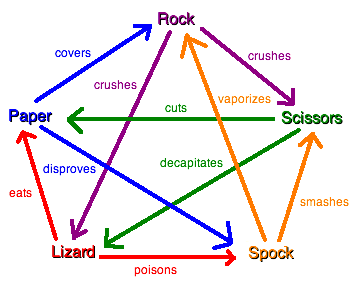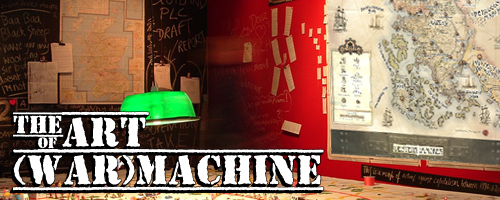With Lock & Load looming closer, it’s taken up a lot of my thoughts, particularly the debut of the new world championship: Iron Gauntlet. Being a brand new format, it’ll be particularly interesting to find out how it’ll develop. Will you see the same big names dominating the tournament scene? Will the same lists be prevalent? Only time will tell.
All pertinent information is here (and here is the document. Go ahead and read, I’ll wait). One of the first things that you’ll note is that the world is divided up into several regions. I certainly appreciate the meticulousness of the map, otherwise who knows what chaos would ensue when a player from Greenland or Nunavut entered? But I digress…
After a year of playing in various qualifying tournaments and accruing points, the top 2 players from each geographic region and 8 wildcard players (similar to how the NFL does the playoffs – hopefully nerd cliches don’t always hold true and you have a passing familiarity with sports) are invited to play in the finals at Lock & Load in Seattle. Due to the tracking of player performance over the year, player seeding in the finals is possible, something that I’m a big fan of.
Interestingly, so far at conventions (Gencon and Lock & Load at least) the Iron Gauntlet qualifier events are run simultaneously with the events that qualify players for Masters at that event, which also qualifies players for the Warmachine Weekend Invitational. It remains to be seen what effect, if any, this will have on either format – the player bases will be mutually exclusive.
Beyond the logistics of the tournament, let’s look at the actual structure of the tournaments themselves, shall we?
- Cross-faction List Pairings – Unlike normal tournaments, you can bring lists that are not in the same faction – running Warwitch Deneghra (a Cryx warcaster) with Major Victoria Haley (a Cygnar warcaster) or Morvahna the Dawnshadow (a Circle warlock) is possible.
- Two Lists Required – Unlike Masters, all points levels of Iron Gauntlet only require 2 lists, which are character restricted as per usual. The character restrictions are less of an issue, since you can possibly draw on two factions’ worth of characters instead of one. This of course also means that you must play each of your lists once.
- Specialists – Unlike normal tournaments, Specialists are included by default. This allows you a limited amount of potential to tailor your list to your opponent.
- Fully Painted – Just like in Hardcore, armies must be fully painted and based.
I believe that these factors all together will produce tournament environments that are drastically different from the norm. Why?
- Specialists will result in the inclusion of models that normally are considered too niche to include in a main list, such as Victor Pendrake, who primarily sees use versus Hordes armies due to his specific abilities. It also helps out armies such as Trollbloods – worried about Menite guns setting things on fire? Take the Pyre Troll. Worried about Storm Striders? Take the Storm Troll. Is your Skorne army going to get shot to pieces by the opposing force? Swap in a Basilisk Krea. Obviously there are limits to the substitutions that can be made, but with enough forethought you can attempt to solve your bad match-ups.
- Since you’re no longer limited to taking lists within the same faction, taking what you consider to be the 2 best possible lists is imperative, not just within your faction. This will most likely result in a concentration of the list of played warcasters/warlocks, since most people will be running casters that frequently fall into the “Best in Show” lists.
- The events being impossible to play in as well as Masters means that you’re going to have a different player base – I suppose that players who have already won a Masters (and qualified for WMW) might play in Iron Gauntlet but if you had any aspirations of getting into that event you’re not going to play Iron Gauntlet. Similarly, if you wanted to play in the Iron Gauntlet finals, you need to play in as many Iron Gauntlet qualifiers as you can to get the most points, which also precludes you from playing in other types of tournaments.
Rock – Paper – Scissors

Or maybe this, if you prefer.
Warmachine/Hordes inherently have some models that work better versus other models – a high volume of accurate low-power shooting or a huge number of AoEs might be good against an infantry swarm but is little use against heavy armour, for instance. Part of the main reason that tournaments usually allow additional lists is to have the ability to not be forced into playing against an army that’s a horrible match for you, and probably unfun.
Of course, building multiple lists within the same faction has become a bit of an art: many different theories exist on the topic, and many better writers have written articles about it, but it mainly boils down to avoiding as many bad matchups for you. Usually certain things can be telegraphed by what lists are available to both opponents – perhaps your opponent cannot run one of his lists versus yours and have a good chance of winning (such as Feora2 against Trollbloods, where the Pyre Troll and the Krielstone are in the lists, giving mass fire immunity), meaning that you can expect that your opponent will not play that one. Conversely, one of your lists might be good against your opponents’: Saeryn is probably one of Legion’s best warlocks to take versus Cryx, so your Cryxian opponent can probably expect you to play her and will plan accordingly.
Beyond extreme cases such as that, there are more nuanced scenarios: If I take X and my opponent plays Y, I’m going to have a hard time. If my opponent plays A and I play B, I’m going to have a much easier time. Any other combination results in a more or less even game. This can result in what a lot of people refer to as “list chicken” – depending on how rough of a time your opponent will have against one of your lists, you can attempt to force them to play the other one. This type of scenario is mainly the purview of game theory mathematics (shocking, I know) or just plain chutzpah.
What does this have to do with Iron Gauntlet? Being able to build two lists that have nothing in common whatsoever means that often one of your lists is a silver bullet to your opponent’s and vice versa. Perhaps even both of your lists are counters to one of your opponent’s, but against the other list it’s a crapshoot. Either way, to me it seems a lot of games are going to be decided by what is essentially a coin flip – did my opponent choose the list that counters my list?
In Conclusion
All in all, I’m very interested to see Iron Gauntlet in action at Lock & Load and what direction it’s going to take the game. It’ll be interesting to see what lists people bring and if my thoughts on the format are true or if my concerns are unfounded. It’ll be intriguing as well to see who does well in this format.
I’ll probably be overflowing with nerd glee from the Convergence in my possession the next time I write, so expect some sort of clockwork-themed entry. Until next time, happy gaming!

